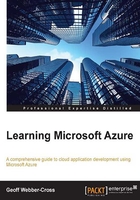
What this book covers
Chapter 1, Getting Started with Microsoft Azure, gives an introduction to cloud computing and Microsoft Azure followed by how to choose a subscription and signing up for a subscription. We finish this chapter by taking a look around the portal, and then start looking at the different services Microsoft Azure has to offer.
Chapter 2, Designing a System for Microsoft Azure, covers designing scalable, resilient systems for Microsoft Azure by looking at methodologies for breaking systems into subsystems and selecting appropriate Azure services to build them. This process will be applied to design a small system for an independent station that requires a website and a basic administration system; it is then extended to a full enterprise system, where will we introduce the Azure Bakery case study.
Chapter 3, Starting to Develop with Microsoft Azure, gives you the first taste of developing for Microsoft Azure, where you will prepare their development environment with the required tools and sign up for a Visual Studio Online account. We'll create the foundations of the sales customer website and publish it to the cloud, and then set up continuous deployment using the Visual Studio Online Team Foundation build server.
Chapter 4, Creating and Managing a Windows Azure SQL Server Database, creates a database for the sales business unit and builds it using Entity Framework Code First Migrations. This chapter will examine different tools for working with the database from a developer and administrator point of view, and look at options for database backup.
Chapter 5, Building Azure MVC Websites, builds the sales customer website and administrator website, with Twitter authentication for the customer site and Azure Active Directory authentication for the administrator site. We will learn how to apply custom domain names and SSL certificates to Azure websites and learn how to perform Azure AD group authorization in an MVC website.
Chapter 6, Azure Website Diagnostics and Debugging, follows on from the previous chapter, exploring techniques and tools to help diagnose problems and debug Azure websites. We'll look at enabling diagnostics in websites, working with logfiles, and examining application logging and site diagnostics. Finally, we'll look at the Kudu service and remote debugging Azure websites.
Chapter 7, Azure Service Bus Topic Integration, starts with an overview of the Service Bus topics and creates a topic for handling order messaging between the three business tiers. We'll integrate the sales customer website into the topic with a subscription, allowing the newly-created orders to be sent across the system, where they will be collected by the production system for manufacturing, and the supply system for producing address labels and planning deliveries. We'll also create a messaging simulator to allow the topic to be loaded up with high volumes of orders to help test the scalability and capacity of the system. Finally, we'll look at the features in the portal to help us monitor and manage our Service Bus topic.
Chapter 8, Building Worker Roles, gives an introduction to cloud services and creating a worker role. Then, we'll create and run a basic cloud service locally on the compute emulator, and publish and run it in the cloud. The production order processor is created next, which is responsible for receiving orders from the Service Bus topic, saving them to the production database, creating product batch schedules, and allocating stock. Finally, we'll test the cloud service in a scaled deployment using the simulator created in Chapter 7, Azure Service Bus Topic Integration.
Chapter 9, Cloud Service Diagnostics, Debugging, and Configuration, continues on from the previous chapter and covers diagnostics, remote debugging, and IntelliTrace. We'll learn how to deal with configuration changes made in the portal at runtime and implement start-up tasks for performing customizations to prepare the server environment for the service.
Chapter 10, Web API and Client Integration, provides an introduction to the Web API and SignalR with an Azure Service Bus backplane followed by building a Web API service and a SignalR hub, to allow the production management application to interact with the production database and Service Bus topic. The system will be authenticated with Azure AD authentication, allowing production staff to log in to the WPF client application using their Azure AD credentials.
Chapter 11, Integrating a Mobile Application Using Mobile Services, brings the whole system together with the addition of a mobile service and a Windows Phone 8 application for the sales system, which allows users to log in with the same credentials as the customer website, view orders, and receive order updates and product news via the notifications hub. The sales mobile service provides APIs for the admin website and order processor to interact with the notifications hub. Finally, the chapter looks at building an Azure AD authenticated mobile service for the supply Windows Store application to view orders and retrieve address labels from a blob storage created by the supply order processor.
Chapter 12, Preparing an Azure System for Production, is the final chapter, and looks at configuring systems for various environments including production, and creating publishing packages using the Visual Studio Online Team Foundation build server and producing database scripts in order to manage the system deployments in a controlled way by systems administrators or developers. We'll learn how to monitor the different services implemented throughout the book once they are live, and also cover guidelines for publishing web-connected mobile applications.